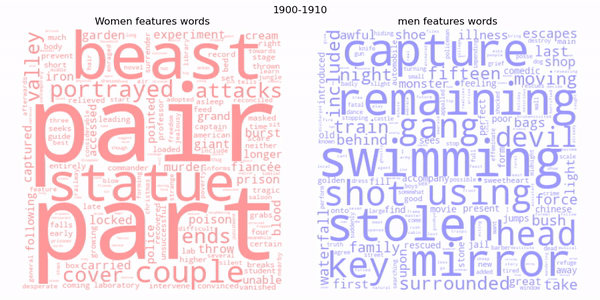Now we will deep dive into the history of women's representation in movies. We already learned a lot till we came here. Over all movies together, we can see that there are more male actors than female actresses. But, we do not know whether the number of female characters in movies changed or not. Are there any differences between the female protagonists and male ones? Is there any historical event that caused a significant change in women's representation?
So, now we are starting to discover the answers of all these questions together. Are you ready?
Let's start by looking at changes in the number of female characters in movie summaries over the years. To do so, we have divided time into 10-year periods.
There is not a significant change in the female characters over decades. Female characters constitute only the 30-35% percentage of the protagonists represented in movie summaries. To be sure about our interpretation, we decided to shorten the interval of time within the period. Now, we will look at the data for 5-year periods.
As we can see, the number of female characters in summaries reached its peak at 52.9% in 1910-1915. When we searched this time period we learned that during the 1910s, women's increasing involvement in the film industry as actors, screenwriters, theater managers, film producers, and directors paralleled the increasing number of women in American workplaces and also vocal and energetic women's suffrage movement effort. The increase in the number of female characters in the movie summary can be related to this historical movements.
Source
Since we only checked the number of female characters in movie summaries, we are still curious about the female protagonists. Now, we will look at the change of protagonists over the years.
We extract the protagonist of the movie as the character which is mostly mentioned in the summary.
First, let’s look at all times and see whether females or males are mostly represented as the protagonists in movies.
Not so surprising… the results are quite similar to the number of female/male character ratios that we showed in the Overview.
However, we want to know whether it was always like that or changed over the years. Our next question is “Did the percentage of movies starring female protagonists change over time?”
Now, we can see that female protagonists in movie summaries also have not evolved significantly over the years. There is a noticeable increase in female protagonists reaching the highest in 1920-1930 which may be the result of vocal and energetic women’s suffrage movement effort that we mentioned previously in our character count analysis.
We have already learned a lot from the data. Movie summaries showed us that females’ appearance in movies as both characters and protagonists has not changed significantly. Female characters and protagonists’ appearance were always less than the males in movies.
Now that we know females are less involved than men in movies, we will ask the last part of our question: How have the adjectives representing women changed over time? To answer this question we will look at the change of adjectives that is used more for females than males over time.

The adjectives that represent females in movie summaries change towards the periods. Females are the most present in romance movies and some remarkable adjectives used for females are “beautiful”, “young” and “married”, we can see them in the word clouds with large fonts in several periods, especially for the last ones. This shows us females are still represented with the physical attributes related to appearance. However, males are more present in action movies explaining the stronger appearance with words like “fire”, and “grab”.
Overall Conclusion
From our analysis in the overview, the summaries and this page, we can see that women are represented in movies in a very different way than men. Women are significantly underrepresented over all movies and appear most often in romantic movies, playing character types such as "dumb blonde" and "brainless beauty". There are also on average younger than the men. In the movie summaries, women are described with more positive adjectives, such as "loving" and "beautiful" while men are predominantly described by words relating to war and conflict. The same applies to the professions men and women occupy in the movies, with women more likely to be portrayed as painters or dancers and men as deputies and generals. When it comes to the evolution of the number of women in movies over time, we do not find noticeable changes within the timeframe of our data (1900 - 2010), apart from a peak from 1910-1915 which corresponds to a strong womens movement at that time. The same applies to women acting as protagonists in movies. For the adjectives describing men and women we observe similar biases over the whole timeframe. These results show us that there is still a need for action towards more inclusion and a more diverse portrayal of female characters in movies. We hope that, by unveiling the prevalent biases and raising awareness about stereotypes, our analysis can be a step in the right direction.
Are you curious to learn about the ethical considerations taken into account while performing this project? You can read about them
here.
